- Basic Suspension Tuning -
With Mark Pavidis
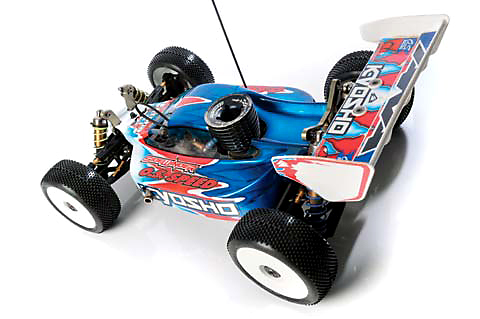 Mark
Pavidis is old school. He’s been making A-mains at big races since some
of today’s younger pro racers were in diapers. He has raced for some of
the biggest companies in our industry, and has helped developed some of
the most influential chassis, tire, and component designs in the RC world.
Mark has been competitive at the top levels of RC racing longer than
anyone from any part of the world, and many racers from any generation
regard him as one of the toughest competitors they’ve ever faced.
Mark
Pavidis is old school. He’s been making A-mains at big races since some
of today’s younger pro racers were in diapers. He has raced for some of
the biggest companies in our industry, and has helped developed some of
the most influential chassis, tire, and component designs in the RC world.
Mark has been competitive at the top levels of RC racing longer than
anyone from any part of the world, and many racers from any generation
regard him as one of the toughest competitors they’ve ever faced.
He has won U.S. National
championships in several classes, including 1/8-Scale Buggy. Along with
Japanese legend Masami Hirosaka, Mark is the only other driver to win
IFMAR World titles in both on-road and off-road competition. Unlike
Masami, or any other driver, Mark is the only driver ever to win IFMAR
World championships in both electric and nitro competitions. His 2006
IFMAR 1/8-Scale Off-Road title reaffirmed his place in RC history as one
of the best racers of all time.
I sat down with Mark at
AKA’s new offices in Murrieta, California, to discuss the most common
adjustments available on today’s nitro buggies. When Mark Pavidis talks
buggy setup, we listen.
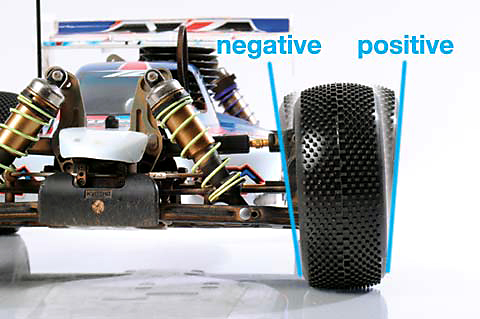 CAMBER
CAMBER
Camber is the relationship of the tire to the ground, such that a tire
that is perpendicular to the racing surface has zero camber. If the top of
the tire leans in toward the car, it has negative camber; likewise, a tire
that leans outward at the top has positive camber.
Front Camber. Adding more
negative camber to the front of your buggy will make your car less
aggressive, especially when turning into the corner. More negative camber
will also lessen the chances that the front tires will catch on ruts or
bumps. Mark says, “On rough or high speed tracks, adding more negative
camber is an important adjustment to make.” It’s usually best to start
with a little bit of negative camber in the front.
Taking away negative camber
(or even adding positive camber) to the front of your buggy takes away a
little bit of overall steering, but will make your buggy steer into the
corner more aggressively since the corner of the tire will dig into the
track’s surface. This can help on slower tracks with plenty of
high-speed corners.
Rear Camber. More negative
camber in the rear tires will free up the rear of the car, making it whip
around by taking away lateral traction. As with the front of the car, more
negative camber will help your buggy navigate through rough sections of
the track.
Running less negative camber
in the rear will take away a little bit of overall steering, but your
buggy will handle more responsively. If the track is not bumpy and has
good traction, try running less negative camber to help carry more speed
through corners.
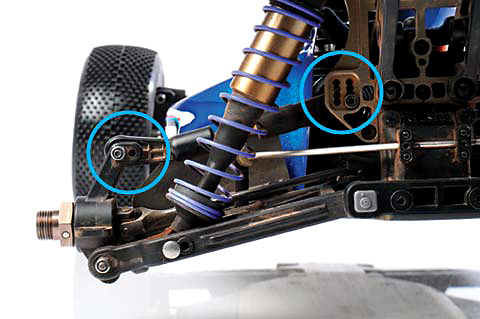 CAMBER
LINK POSITIONS
CAMBER
LINK POSITIONS
The optional camber link mounting holes alter the rate at which the camber
angle changes throughout the suspension’s movement. For the purposes of
making only the following changes, you should reset your camber angles
after moving the camber link locations.
Front
Outside (on the front hub).
A longer link means the camber will change less as the suspension
compresses, which will make the car turn in harder but push exiting the
corner.
Moving to the inside hole will give more camber rise, which smooths out
initial turn-in but adds steering through the middle and exit of the
corner.
Inside (on the shock tower).
Raising the inner mount will keep the front end more flat. On high bite
and smooth track, this will smooth out your car’s steering response and
make it easier to drive.
Lowering the inner mount will add body roll and make the car more
aggressive. Mark almost always runs the lowest hole available.
Rear
Outside (on the rear hub).
A longer link gives less camber rise, which means less traction. On a high
speed track with high grip, this will add more support by eliminating body
roll.
A shorter link equals more camber rise and more traction. Because a
shorter link will make the rear of the car feel softer, it will better
handle rough sections of the track.
Inside (on the shock tower).
Moving the inner camber link mount to the inside or outside hole will have
the same effect as changing the length of the link on the hub.
Raising the link on the rear shock tower will keep the buggy flat through
corners and have less camber rise; this is a good adjustment to make on a
smooth track with high traction.
Lowering the link will add camber rise and make the car more forgiving
when the track is rough.
Moving the link out on both the shock tower and the hub, which will keep
the camber link the same length, will add support and make the rear of the
car feel stiffer.
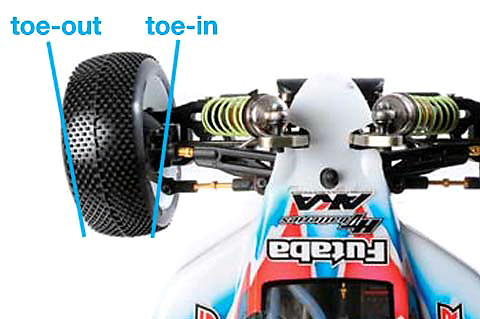 TOE-IN
/ TOE-OUT
TOE-IN
/ TOE-OUT
This is the angle of the tires when compared to the centerline of the car.
A tire that has zero toe is pointing straight ahead. Toe-in means that the
tires point in toward each other, while toe-out is the opposite.
Front Toe
1/8-Scale Buggies almost always run toe-out in the front. Adding more
toe-out will make the car smoother and easier to drive on big tracks, as
well as increase low-speed steering by decreasing the car’s turning
radius.
Likewise, decreasing toe-out (even to the point of running zero toe) will
give the car more initial steering response. This is usually only done on
tight, low-speed tracks.
Mark says, “If you run toe-in (at the front), your car won’t come out
of the corner very well, and initial turn-in will be too darty. If you run
toe-out, it will turn in and come out of the corner much smoother.”
Rear Toe
The rear of the car is much different, as toe-out is never used. Adding
more rear toe-in will add overall rear traction, both in a straight line
and during cornering.
On the flip side, less toe-in will increase steering since the rear tires
will have less traction. Also, the rear suspension and driveshafts will be
at less of an angle, which will help on rough sections of the track.
Mark says, “Nine times out of ten, I run maximum rear toe-in (on the
Kyosho MP9, this is three degrees of toe-in per side). The only time I run
less is in truggy, because there’s already so much grip.” Also, he
suggests only changing the inner pivot blocks to adjust toe-in rather than
using rear hubs with different angles of toe-in. Changing the rear hubs
will increase the angle of the driveshaft joint and change how the car
works.
KICK-UP
Kick-up is the angle between the ground and the lower inner hinge pins on
which the suspension arms swing. Altering kick-up will affect the car much
like caster does. In addition, adding kick-up will make your bump higher
and further. You should only consider decreasing kick-up when the track
has few or no jumps.
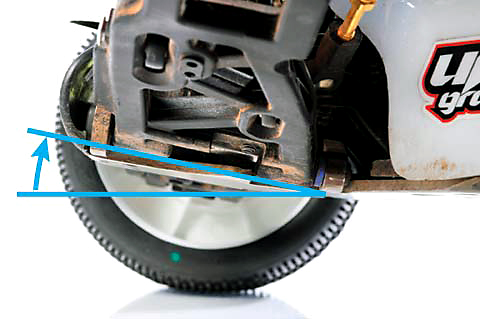
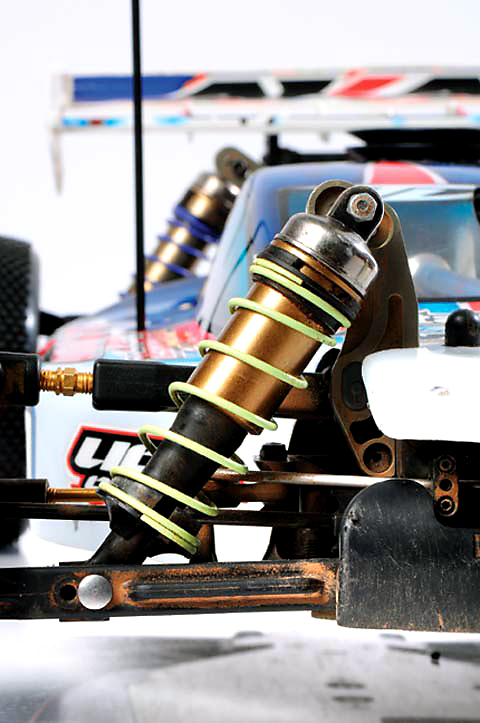 SHOCK POSITION
SHOCK POSITION
Tower. Moving the shock in on the tower will make the shock feel
more progressive i.e.; initially it will feel softer, but increasing
in stiffness as the shock compresses. If the track is slippery, move
the shock in on the tower to add body roll and overall traction.
Moving the shock outward will make the shock feel more linear. This
will free up the car and make it jump much better. On a track with
lots of grip, move your shocks out on the tower to reduce body roll.
Arm. Moving to a more
inward shock location on the arm will make the buggy feel softer and
less stable. For blown out tracks, this adjustment will help
navigate bumps and ruts without hurting the car’s jumping
performance as much as moving the shock inward on the tower.
An outer shock position on the arm will make the car rotate more
during cornering, and make the buggy feel more stable. This comes at
the expense of rough track performance.
SHOCKS
Shock Oil. Thicker shock oil will help the car to navigate larger
jumps and bumps since the oil will slow the reaction of the shock.
In hot weather, increase the weight of your shock oil to maintain
the same damping characteristics.
Thinner shock oil will allow the shock to react more quickly, and
help your buggy soak up smaller bumps and track imperfections. If
your buggy works well in warm weather, switch to thinner shock oil
in very cold conditions.
Mark explains, “Temperature is a huge part of choosing shock
oil.”
Shock Pistons. Choosing
the correct shock pistons is quite simple. On smooth tracks with big
jumps, Mark suggests using smaller pistons to slow down the shock
action. On rough tracks with fewer jumps, reach for pistons with
larger holes to allow the shock to soak up the ruts.
Shock Springs. Mark
doesn’t often change his shock springs to adjust his car. In fact,
he suggests changing both the front and rear springs at the same
time to maintain the same balance front to rear. If the track
surface is slippery, go to lighter springs to create more body roll
and slow the car’s reactions. On asphalt, grass or Astroturf
tracks with tons of grip, use heavier springs at both ends of the
car to resist traction rolling.
CONCLUSION
As you’ll notice, each adjustment sacrifices a particular handling trait
to gain another. There’s no magic adjustment to make your car “super
dialed”, so decide what your buggy needs to do differently, make changes
to your car, and see if your lap times improve. This guide should serve as
a perfect compliment to the most useful tool you’ll ever find in your RC
career: practice.

